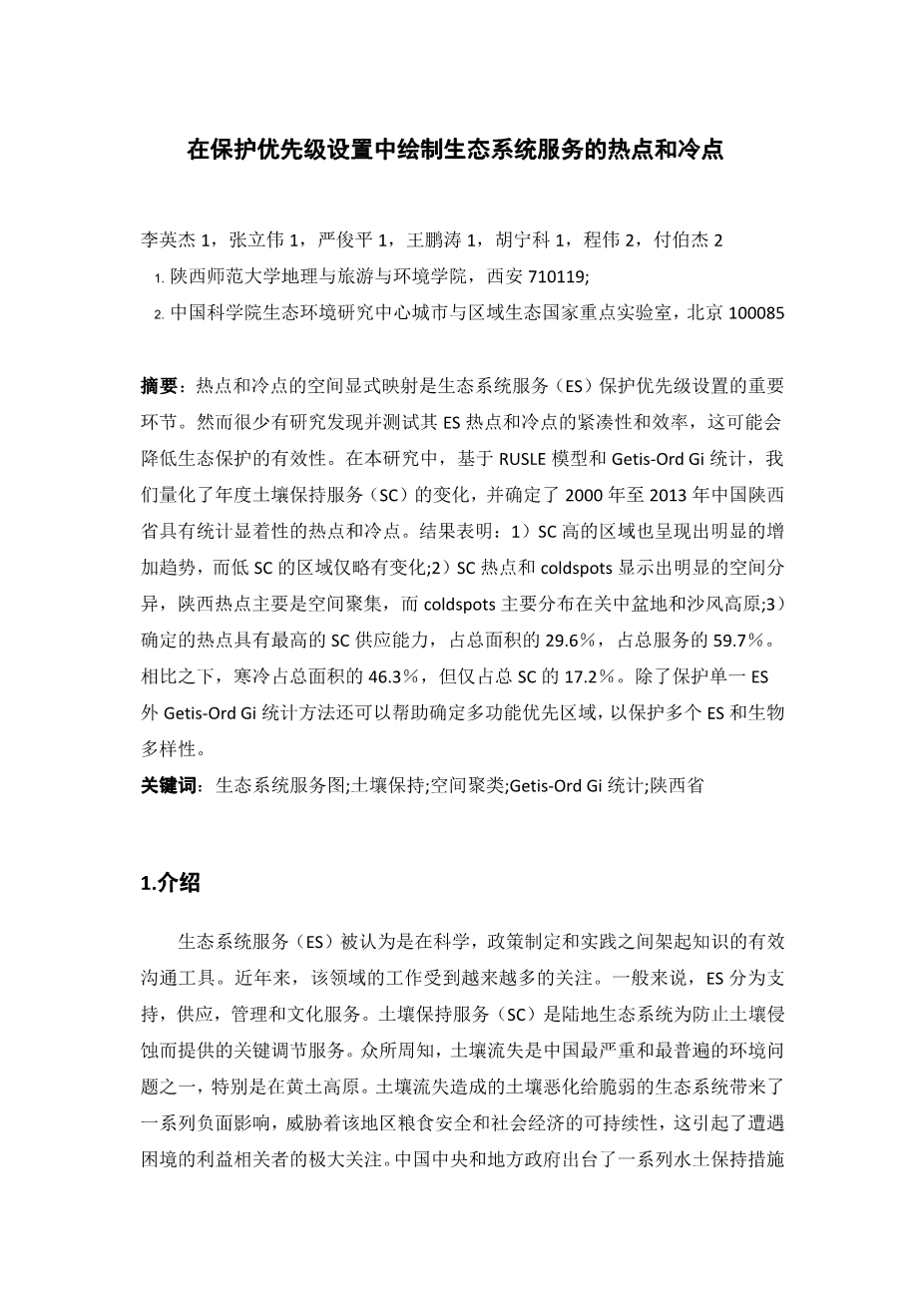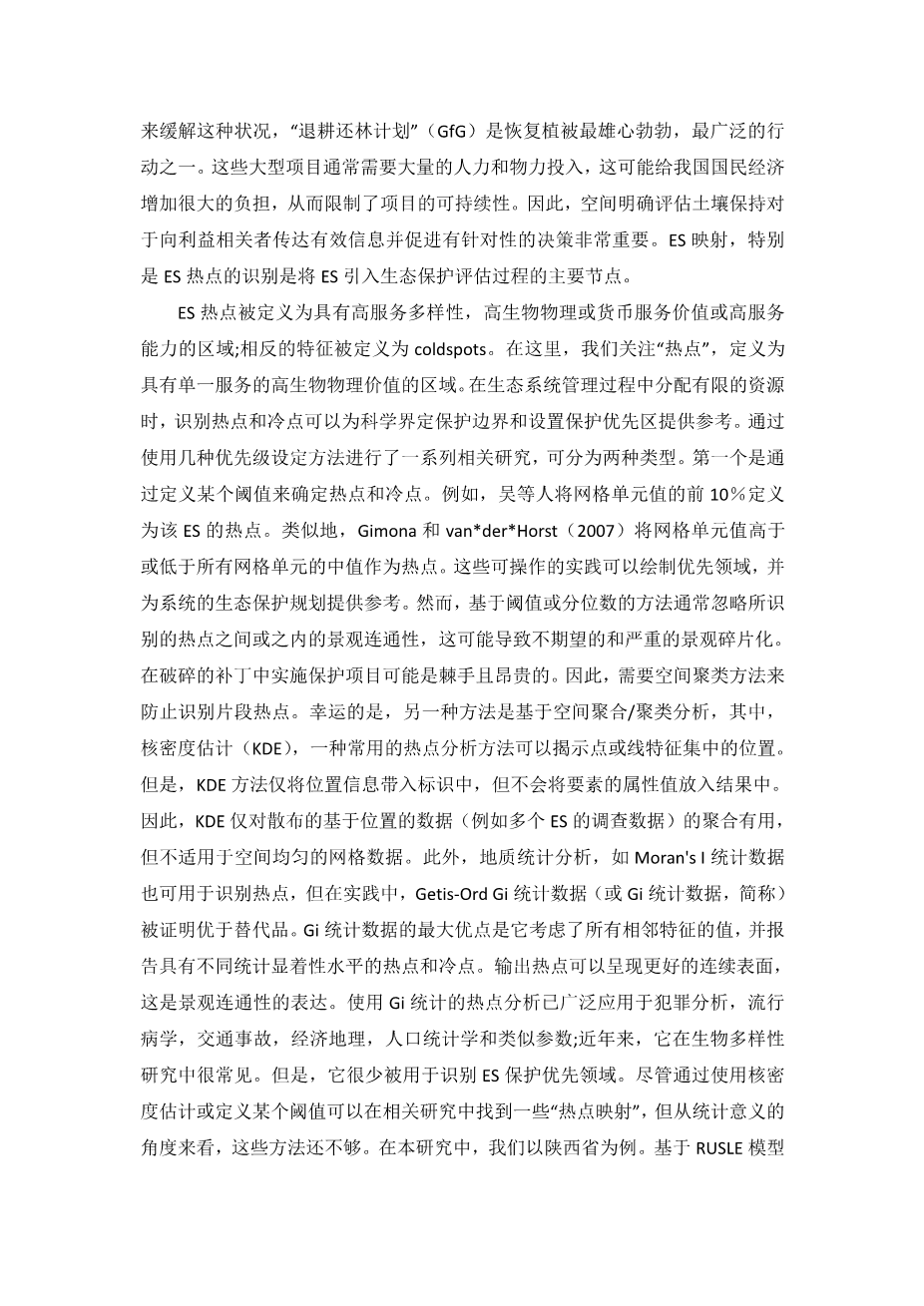Mapping the hotspots and coldspots of ecosystem services in conservation priority setting
LI Yingjie1, *ZHANG Liwei1, YAN Junping1, WANG Pengtao1, HU Ningke1, CHENG Wei2, FU Bojie2
- Department of Geography, Tourism and Environment College of Shaanxi Normal University, Xi'an 710119, China;
- State Key Laboratory of Urban and Regional Ecology, Research Center for Eco-Environmental Sciences, CAS, Beijing 100085, China
Abstract: Spatial-explicitly mapping of the hotspots and coldspots is a vital link in the priority setting for ecosystem services (ES) conservation. However, little research has identified and tested the compactness and efficiency of their ES hotspots and coldspots, which may weaken the effectiveness of ecological conservation. In this study, based on the RUSLE model and Getis-Ord Gi* statistics, we quantified the variation of annual soil conservation services (SC) and identified the statistically significant hotspots and coldspots in Shaanxi Province of China from 2000 to 2013. The results indicate that, 1) areas with high SC presented a significantly increasing trend as well, while areas with low SC only changed slightly; 2) SC hotspots and coldspots showed an obvious spatial differentiation—the hotspots were mainly spatially ag- gregated in southern Shaanxi, while the coldspots were mainly distributed in the Guanzhong Basin and Sand-windy Plateau; and 3) the identified hotspots had the highest capacity of providing SC, with 29.6% of the total area providing 59.7% of the total service. In contrast, the coldspots occupied 46.3% of the total area, but only provided 17.2% of the total SC. In addi- tion to conserving single ES, the Getis-Ord Gi* statistics method can also help identify multi-functional priority areas for conserving multiple ES and biodiversity.
Keywords: ecosystem services mapping; soil conservation; spatial clustering; Getis-Ord Gi* statistics; Shaanxi Province
Introduction
Ecosystem services (ES) are regarded as an effective communication tool to bridge the knowledge between science, policy making, and practice. Work in this field has gained in- creasing attention in recent years (Trabucchi et al., 2014; Guerra et al., 2016). Generally, ES
are grouped into supporting, provisioning, regulating, and cultural services (MA, 2005; Adhikari and Hartemink, 2016). Soil conservation service (SC) is a critical regulating ser- vice supplied by terrestrial ecosystems to prevent soil erosion. It is well known that soil loss is one of the most severe and widespread environmental problems in China, especially in the Loess Plateau (Fu et al., 2011). The soil deterioration caused by soil loss brings a series of negative impacts on the fragile ecosystem, threatening the sustainability of the food security and social economy in the region (Fu et al., 2005; Fu et al., 2011; Guerra et al., 2016), which have drawn much attention from the stakeholders who suffered the dilemma (Fu et al., 2015). The Chinese central and local governments launched a series of soil and water conservation measures to alleviate this situation, and the Grain-for-Green Program (GfG) is one of the most ambitious and widespread actions to restore vegetation. These kinds of giant projects usually need an enormous investment of manpower and material resources, which may add a great burden to our national economy and consequently restrict the sustainability of the pro- jects. Thus, spatial-explicitly assessing soil conservation is of great importance to convey effective messages to the stakeholders and facilitate targeted decision making. ES mapping, especially the identification of ES hotspots is a primary node bringing ES into the process of ecological conservation assessment.
ES hotspots are defined as regions with high service-diversity, high biophysical or mone- tary value of services, or high capability of supplying services; the opposite features are de- fined as coldspots (Li, 2014; Schröterand Remme, 2016). Here, we focus on “hotspot” de- fined as areas with a high biophysical value of a single service. Identifying hotspots and coldspots can offer a reference for scientifically defining conservation boundary and setting conservation priority area when allocating limited resources in the process of ecosystem management (Reyers et al., 2009; Zhang and Fu, 2014). A range of relevant research has been performed by using several priority-setting approaches (Trabucchi et al., 2013; Zhang et al., 2014), which can be classified into two types. The first one is by defining a certain threshold to determine hotspots and coldspots. For example, Wu et al. (2013) defined the top 10% of the grid cell value as the hotspots of that ES. Similarly, Gimona and van der Horst (2007) counted the grid cells values above or below the median value of all grid cells as hotspots. These maneuverable practices can map priority areas and provide references for systematic ecological conservation planning. However, threshold or quantiles-based method usually ignore the landscape connectivity between or within the identified hotspots, which can lead to undesirable and severe landscape fragmentation. Implementing conservation projects in fragmentized patches can be thorny and costly (Mitchell et al., 2015). Thus, spatial clustering methods are needed to prevent identifying fragmentary hotspots. Fortu- nately, another type of method is based on spatial aggregation/clustering analysis, among which, Kernel density estimation (KDE), a frequently used hotspot analysis method can reveal where point or line features are concentrated (Alessa et al., 2008). However, the KDE method onl
剩余内容已隐藏,支付完成后下载完整资料


英语译文共 11 页,剩余内容已隐藏,支付完成后下载完整资料
资料编号:[431585],资料为PDF文档或Word文档,PDF文档可免费转换为Word
以上是毕业论文外文翻译,课题毕业论文、任务书、文献综述、开题报告、程序设计、图纸设计等资料可联系客服协助查找。
您可能感兴趣的文章
- 基于真实完整性原则的旅游规划:以连云老区保护与开发为例外文翻译资料
- 规划一个可持续发展的新城外文翻译资料
- 历史街区与现代城市之间的有机秩序:以哈尔滨花园街历史街区概念规划为例外文翻译资料
- 中新天津生态城融资: 其他大型可持续城市项目可以吸取哪些教训?外文翻译资料
- 北印度城市土地利用动态与城郊增长特征对总体规划和城市适宜性的影响外文翻译资料
- 基于生产、生活、生态一体化的美丽乡村建设规划一以遂宁市白寨村为例外文翻译资料
- 加强区域旅游竞争力战略外文翻译资料
- “城乡统筹”和“两型社会”背景下新农村规划设计探讨:以湖南省望城县光明村规划为例外文翻译资料
- 中国农村治理体系的演变及其对农村空间规划的影响外文翻译资料
- 从繁荣到消失:宁波市双桥村的社会与空间转型外文翻译资料


